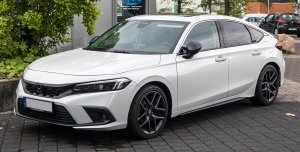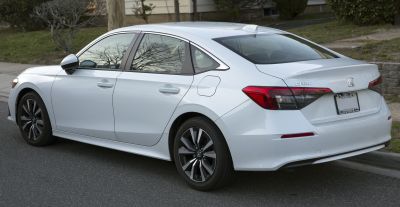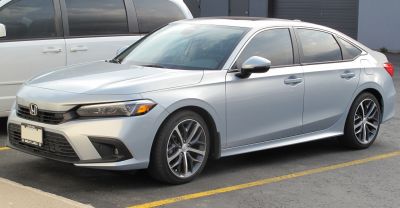Honda Civic

- Year: 1972
- Status: in_production
- Also Called:
- Honda Ballade (1980–2001)
- Honda Integra SJ (1996–2001)
- Honda Domani (1997–2000)
- Honda Integra (China, 2022–present)
- Acura EL (Canada, 1997–2005)
- Acura CSX (Canada, 2005–2011)
- Isuzu Gemini (Japan, 1997–2000)
- Isuzu Vertex (Thailand, 1996–2001)
- Rover 200 (1984–1989)
- Triumph Acclaim (1981–1984)
The Honda Civic is a compact car known for its sporty handling, fuel efficiency, and reliability. Offered in various body styles over its long production history (sedan, hatchback, coupe), the Civic has consistently maintained a strong reputation for its balanced performance and user-friendly features. Engine options have varied over the years but generally range from efficient petrol engines to more powerful options. The Civic emphasizes a driver-focused experience, offering responsive handling and comfortable interiors. Depending on the model year and trim level, features can range from basic necessities to advanced infotainment systems, safety features (including driver-assistance technologies), and premium materials. The Civic has consistently ranked highly in reliability surveys and remains a popular choice for those seeking a blend of performance, practicality, and dependability in a compact car.
Generations
First generation (1972)
The Honda Civic's first generation (1972-1979), launched amidst the 1973 oil crisis, was a revolutionary subcompact. Its fuel efficiency, achieved through a lightweight design and a tiny 1.2L four-cylinder engine, quickly gained popularity. Available as a two-door sedan and three-door hatchback, it offered surprisingly spacious interiors for its size and showcased Honda's innovative engineering. While lacking the power and features of larger cars, its reliability and affordability solidified Honda's reputation in the burgeoning US market, proving that small could be mighty and highly desirable. The car’s simple, unadorned styling became synonymous with practicality and efficiency.
Second generation (1979)
The second generation Civic (1979-1983) expanded on the original's success, offering a more rounded and aerodynamic design compared to its boxy predecessor. Engine options grew slightly, with larger displacement engines providing more power, though fuel efficiency remained a priority. This generation saw the introduction of a 5-door hatchback, further increasing practicality. Critically, Honda introduced CVCC technology (Compound Vortex Controlled Combustion), a crucial emission control system that met stringent US environmental regulations without sacrificing performance significantly. This helped cement Honda's reputation for environmentally conscious engineering and continued to attract buyers seeking both frugality and responsible motoring.
Third generation (1983)
The third-generation Civic (1983-1987) represented a significant leap forward in design and refinement. Its sharp, wedge-shaped styling was a departure from the softer lines of its predecessors and projected a more modern image. This generation featured a front-wheel-drive layout across all models and a wider range of body styles, including a 3-door hatchback, a 4-door sedan, and a wagon. The introduction of fuel-injected engines improved performance and throttle response, while the chassis was notably improved, providing better handling and a more refined ride quality. The introduction of more luxurious trims signaled Honda's ambitions to move beyond its purely utilitarian image.
Fourth generation (1987)
The fourth generation Civic (1987-1991) further refined the design language of its predecessor, featuring a more aerodynamic profile and a slightly more luxurious interior. However, a key characteristic of this generation was its emphasis on versatility and functionality. Honda introduced a longer wheelbase, resulting in noticeably increased interior space, and a wider array of trim levels cater to a broader range of customer preferences. While engine options remained relatively small in displacement, improvements in efficiency and technology continued to provide commendable performance. The CRX, a sporty two-seater coupe based on the Civic platform, became a cult classic within the model’s lifespan.
Fifth generation (1991)
The fifth generation Civic (1991-1995) marked a major design shift, incorporating a more rounded and aerodynamic body. This generation prioritized interior space and comfort, offering a significant increase in both compared to previous iterations. The chassis was redesigned for enhanced handling and ride quality, further improving on the refinement established in earlier generations. Engine options expanded slightly, with larger engines providing more power for those who desired it, but fuel efficiency remained a core value. Safety features were also improved, reflecting a growing awareness of automotive safety within the industry. This generation laid the groundwork for the Civic's continued success by blending practicality, performance, and improved comfort.
Sixth generation (1995)
The Honda Civic of the sixth generation (1995-1999) marked a significant departure from its predecessors, boasting a more rounded, aerodynamic design compared to the boxier shapes of earlier Civics. This generation offered a wider range of body styles including a coupe, sedan, hatchback, and even a station wagon in some markets. While retaining Honda's reputation for reliability and fuel efficiency, the sixth-gen Civic introduced a more refined interior and improved handling, solidifying its position as a popular compact car. Engine options typically included a 1.6L four-cylinder, offering a balance of performance and economy. Safety features were enhanced compared to previous generations, although advanced safety tech remained relatively sparse compared to modern standards. This generation was particularly notable for its affordability and practicality, making it a common choice for first-time car buyers and budget-conscious consumers.
Seventh generation (2000)
The seventh-generation Honda Civic (2000-2005) refined the formula established by its predecessor, further enhancing its styling with a more sculpted and aggressive look. This generation saw the introduction of a more powerful 1.7L VTEC engine, offering improved performance and fuel efficiency. The interior received a significant upgrade, featuring improved ergonomics and higher-quality materials. While still prioritizing practicality, the seventh-gen Civic leaned more towards a sporty aesthetic, appealing to a slightly younger demographic. Safety features remained a focus, with improvements in passive safety systems like airbags. The introduction of various trim levels offered consumers a greater choice in features and specifications, ranging from basic economy models to more upscale options. This generation also marked the start of a consistent design language that would continue throughout the next few generations.
Eighth generation (2005)
The eighth-generation Honda Civic (2005-2011) represented a significant evolution, adopting a more mature and sophisticated design. This generation saw a notable increase in size, moving further away from the compact car roots of earlier generations, but still maintaining its renowned efficiency. It offered a wider range of powertrain options, including a 1.8L four-cylinder engine, and notably in some markets, a 2.0L four-cylinder for sportier Si models and a hybrid version. Safety was once again a priority, with the introduction of more advanced features, although many remained optional. The interior was significantly upgraded in terms of comfort and refinement, featuring better materials and improved build quality. This generation is often praised for its balance of practicality, performance, and fuel economy, consolidating its success in the competitive compact car market.
Ninth generation (2011)
The ninth-generation Honda Civic (2011-2015) maintained the growth trend of its predecessor, resulting in a larger and more spacious vehicle. Design-wise, it shifted towards a more angular and futuristic aesthetic, a departure from the softer lines of the previous generation. Honda focused on improving fuel efficiency even further, introducing more efficient engines and advanced technologies. While maintaining its reputation for reliability, this generation faced some criticism regarding the quality of interior materials, which were perceived by some as less refined than in previous models. Safety remained a key element, with the availability of more advanced safety features like lane departure warnings becoming more common across the various trims. This generation also showcased a more sophisticated infotainment system.
Tenth generation (2015)
The tenth-generation Honda Civic (2015-2021) marked a significant design overhaul, reverting to a more sleek and sporty profile compared to the somewhat controversial styling of its predecessor. This generation significantly improved the driving dynamics and handling, receiving considerable praise for its engaging performance. The interior also benefited from a more modern and premium feel, with better materials and a more driver-focused design. The tenth generation saw the introduction of turbocharged engine options, boosting performance significantly, while still providing decent fuel efficiency. Advanced driver-assistance systems became more prevalent, reflecting the increasing importance of safety technology in the automotive industry. This generation is widely considered a high point for the Civic, receiving acclaim for its improved design, refined performance, and advanced features.
Eleventh generation (2021)
The eleventh-generation Honda Civic (2021) marked a significant departure from its predecessors, embracing a more mature and sophisticated design. Available in sedan and hatchback body styles, it featured a lower, wider stance compared to the previous generation, enhancing its sporty appeal. Under the hood, the powertrain options varied by region, offering a choice of turbocharged four-cylinder engines paired with either a continuously variable transmission (CVT) or a six-speed manual (in select trims). Inside, the cabin boasted a more refined and upscale feel, with a driver-focused cockpit, improved materials, and a larger infotainment touchscreen. Safety features were also significantly upgraded, incorporating Honda Sensing, a suite of advanced driver-assistance systems including adaptive cruise control, lane-keeping assist, and collision mitigation braking. The 2021 Civic emphasized a balance of practicality, fuel efficiency, and a more engaging driving experience compared to its more comfort-oriented predecessors.

